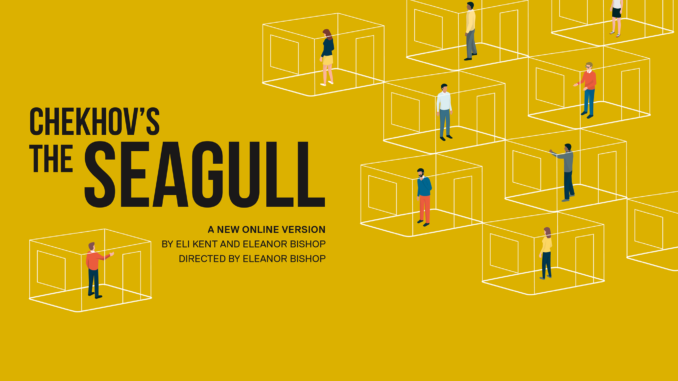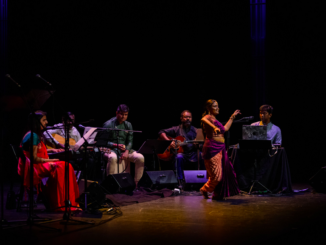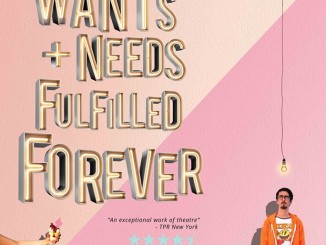
During the Covid-19 lockdown, Auckland Theatre Company launched a four episode adaptation of Anton Chekhov’s The Seagull created within the constraints of social distancing at the time. Using the now widely used Zoom app as its mode of production, it was also set within the world of Zoom too, placing its characters squarely within the circumstances of our global pandemic. Nathan Joe responds.
ADAPTATION This isn’t the first time either co-writers Eleanor Bishop (BOYS, Mrs. Warren’s Profession) and Eli Kent (Peer Gynt: Recycled) have adapted a classic from the theatre canon. It is, however, certainly the adaptation that feels the most situated in the immediate present. This isn’t a period drama or set in some vague place or time. It’s very much 2020 New Zealand in the midst of lockdown.
The question of adaptation is always the extent in which the adapter takes liberties with the text. How much stays the same is as important as how much changes. Translation, by its very nature, is adaptation by necessity. There is no such thing as a faithful translation – all translations must practice some level of infidelity to the original text. It is a complex science, creating a cocktail that is at once fresh and exciting, while remaining true to the spirit of something. Go too far in one direction and you lose the respect of the play’s ardent admirers. Play it too safe and people wonder why you bothered at all.
ATC’s last Chekhov adaptation was The Cherry Orchard, which was given a localised 1970s period treatment. In The Seagull, by keeping the names of the characters the same as their Russian counterparts, Bishop and Kent are almost daring the audience to make comparisons to the original The Seagull. I find myself constantly searching for the parallels, to see the ways this version and my memories of the original bump up against each other.
COLOURBLIND CASTING With a cast including Arlo Green, Fasitua Amosa, Goretti Chadwick, Mustaq Missouri, and Shadon Meredith, the creative team has made a conscious choice to go with colourblind casting. Non-white bodies existing in Chekhov’s world without a need to justify their existence. It’s refreshing to see a 50 percent POC cast in a “mainstage” production that doesn’t have ethnic specifications.
Actually, Shadon Meredith’s casting as Trigorin, is a slight exception. His casting isn’t colourblind; it’s colour-conscious. Though race is never addressed in the text, Trigorin as played by Meredith has more than a few striking similarities to real-life Māori director Taika Waititi. It’s a reminder of the simple power in placing a body on stage. That the body is a potent signifier and metaphor in itself.
MISE-EN-SCÈNE ATC’s The Seagull makes a virtue out of the obstruction of Zoom. What might otherwise be a gimmick has us see it as a complete reflection of its form and structure. Whereas on stage, we are concerned with everything we see on stage, Zoom forces the audience and the makers to focus on everything we see on screen.
The unique filmic convention of the close-up is used to repeated effect here. It’s a tool that can generate intimacy between performer and audience that the stage cannot. This is doubled several times over by having multiple screens at once, different characters inhabiting the zoom medium for intimate two-hander scenes to raucous ensemble pieces.
By the same token, empty spaces, cameras pointed towards spaces without bodies becomes disarming. Gazes left unreturned, gazes averted, actors staring down the barrel of the camera. In a simple moment, Arlo Green’s Konstantin moves out of frame, but his body remains visible through the reflection of a background mirror.
The inherent awkwardness of communication over zoom – with its delays and pauses – sentences delivered simultaneously to everyone connected and to no one at all – makes Chekhov’s own portrayal of failed communication more palpable than ever.
IS THIS THEATRE? In discussions to describe ATC’s The Seagull as an innovative piece of theatre, I find myself resisting the categorisation. Simply being based on a play doesn’t make something theatre. This version of The Seagull isn’t even a live event (though recorded in ‘one take’ and edited for release on the same night gives it an immediacy); it is a fixed product that is in no way influenced by how the audience engages with it. Nor is it a recording of a theatre show. Can watching something on Facebook Live ever approximate the live experience? It shares more in common with underrated Lisa Kudrow vehicle Web Therapy or John Cho vehicle Searching.
Yet, to say it is not theatre is not to dismiss its literary qualities. It’s a fine adaptation of the play, written superbly when you consider the quick turnaround. And it’s certainly innovative for its aforementioned use of the medium. But my mind can’t see it as anything beyond a digital film or a tv series in four parts.
In the first episode, Konstantin’s play is described as a digital event. A knowingly tongue-in-cheek usage of the term or a complicated attempt to express the makers’ own ambivalence in labelling The Seagull itself?
ART The innovative use of form to create this particular production of The Seagull feels like an appropriate expression of the play’s own concerns with form. Mainstream art versus radical experimentation is an argument and anxiety expressed time and time again.
The Seagull becomes a fascinating hall of mirrors in reflecting this concern. Trigorin and Konstantin representing the two poles. The Seagull too is literally the resulting product of crossing the old (Anton Chekhov) and the new (Zoom). Then we also have the cross-section of the creators, millennial theatre-makers Eleanor Bishop and Eli Kent with a mainstage theatre company.
COMEDY OR TRAGEDY Chekhov’s labelling of The Seagull as a comedy has always struck me as somewhat ironic, not to discredit the glimpses of humour running through it. Director Eleanor Bishop mines the laughs carefully, never letting the tone veer too heavily in one direction or another. It’s callousness and a lack of self-awareness cripples many of the characters, which is generally the source of both the comedy and the tragedy.
WEALTH It’s hard to ignore the wealth that emanates from the characters. It’s true to the concept of Chekhov’s bored, upper middle class, but when localised, the class status of some of the characters becomes too personal to me. When the characters are Russians from another period, they’re abstracted to the point of becoming simply characters. When they’re like us but not like us, it’s as if the tiny gap that separates these Kiwis from Kiwis I know feel more immense than ever. A stark reminder that there is a difference of class in New Zealand, separating the haves from the have nots.
At times, there is something that reduces the universality of the piece to something more petty, like a reality tv programme of a rich family squabbling. A Kiwi Keeping Up with the Kardashians. I’m not relating to them so much as simply observing them – a judgemental voyeur.
LOVE The great theme recurring throughout Chekhov’s dramas is love. The characters are thrust into love triangles – longing and yearning dripping off their sentences. It’s the same material soap operas are woven from, but Chekhov tempers it with restraint. A restraint that Eleanor Bishop clearly admires. In this version, Bronwyn Ensor’s Masha brings great awareness to this – skewering the trope of ‘Will they or won’t they’ with a dismissive ‘they don’t.’ There is no Ross and Rachel in The Seagull, no grand romantic gestures, just the unhappy lives of loves not returned. Or loves woefully misdirected.
I’m reminded of Alain de Botton’s idea that every adult life is defined by two great love stories. The first and more obvious is “the story of our quest for sexual love.” The second is “our quest for love from the world.” He calls the second more secret and more shameful. The Seagull is, in many respects, about the impossibility of these two things sitting comfortably together.
Trigorin and Arkadina are the characters with the most success – the most love from the world. It’s this very success that causes others to gravitate towards them and envy them. But we also sense, greatly, their need for this first love – the sexual or romantic kind. Jennifer Ward-Lealand as Arkadina expresses this profoundly when she pleads for Trigorin to stay, chastising him for his flirtations with the younger Nina. It’s one of her few moments of vulnerability.
Arlo Green as Konstantin, by the final act of The Seagull, appears to us like a dead man walking. He has finally found success in his writing, claiming love and validation from the external world for his art. But he has lost Nina. A tragic reversal.
SUBTEXT For a playwright so associated with being a master of subtext, I’m struck by how often characters simply say how they feel. They wear their hearts on their sleeves to a dangerous fault, exposing themselves to hurt, as well as hurting others. It’s like they can’t help being a series of open wounds.
Masha doesn’t hide how much she loves Konstantin. Nina doesn’t hide how much she loves Trigorin. It’s in their lack of subtext that they hurt the ones that love them the most. They can’t even try to pretend otherwise. No one’s feelings are spared.
NINA’S SPEECH I’ve always found Nina’s final speech difficult as an actual text to deliver. So unnecessarily heavy-handed in its use of metaphor (yeah, I get it, you’re THE SEAGULL). There’s something almost comical about it, easily tipping over from pathos to bathos.
And yet it rings somehow true here. Despite my reservations, I find myself deeply invested. This is the moment where Nina recalls where everything went wrong. Where an act of violence to a bird transcends metaphor. Where she sees herself from the outside for a single moment. Where language itself tumbles violently.
Nathalie Morris makes this moment of horrific clarity palpable. The camera catches her surrounded by the darkness, a flickering candle soon to be snuffed out. She’s there, offering a brief moment of false hope before disappearing forever.
SUICIDE The Zoom medium allows Konstantin’s death to be more subtle and obscured than the stage would allow. It feels more real than theatre. Then there’s also the lens of watching it through a lens of prior knowledge, adding to the death a layer of the deploy inevitable. I wonder how newcomers to The Seagull experience Konstatin’s arc. For me, it is like watching a slow motion car crash.
To watch The Seagull is to watch a man driven to suicide by the world around him, by loved ones too consumed by their own problems to see someone hurt. It’s not intentional callousness that results in Konstantin’s death, simply a series of unfortunate circumstances exacerbated by people busy being the main characters of their own narratives.
Suicide, as a plot device, can feel needlessly misanthropic. While it doesn’t erase the deep humanism running through Chekhov’s work, there is something cold and alienating about seeing (or not seeing) a man shoot himself off-screen in the digital age. Like watching a punishing European arthouse film by Lars Von Trier or Michael Haneke. Or, perhaps more disturbingly, like stumbling across a snuff video from the dark corners of the internet.
All episodes of The Seagull are available to watch online for free until Friday 3 July.




Leave a Reply